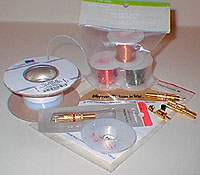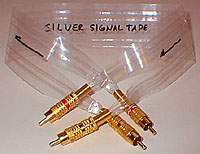![[SoundStage!]](../sslogo3.gif) Synergizing with Greg Weaver Synergizing with Greg WeaverBack Issue Article |
| February 1998 Silver
Signal Tape You should know that my third audio axiom is "Wires are components." That said, some time ago I got frustrated with the bucks I would have to shell out to get wires that sounded great. So, one day way back in the spring of 1988, brother audiophobe Matt Eggleston and I embarked on an experiment to build great sounding interconnects for the handful of bucks we had available to us. It would seem that Matt and his father had done some similar experiments back in Matt’s childhood with remarkable success. This seems to be one of those "cyclic" DIY ideas that comes and goes through each new generation of audiophobe. But hey, what do you say we ninety-ize it? My first trials were done with magnet wire, which is simply single conductor copper wire which has been coated with enamel as an insulating material. This type of wire is commonly used to wind coils for electric motors and inductors. The easiest place to find magnet wire is at your local Radio Shack. Some electric supply houses carry it, but I chose to save time and purchased the Radio Shack Magnet Wire pack (Cat. No. 278-1345a) which contains one 40' spool of 22 AWG, one 75' spool of 26 AWG and one 200' spool of 30 AWG, all for a grand total of $3.99. No doubt because of all my recent hang time with Pierre Sprey of Mapleshade Productions, and all his harping on the idea that "thinner is better," I used the 30 gauge (the bigger the number, the thinner the wire) magnet wire for my experiments - with superlative results!
Another thing I decided to do differently from past attempts was to use 2" wide clear packing tape from 3M fashioned from polyurethane (a very good dielectric) to hold the wires a consistent distance from one an other. In past experiments, I have just let them hang loose (BAD idea) or braided them. The braiding yields decent results, but not what you will hear from the following construction. To start your cables, measure out four lengths of wire which correspond to the final running length of the cable you wish to produce. I will tell you that longer runs will likely require the assistance of a helper to assemble, as managing the wire and tape at distances over about six feet is a challenge. Using a knife (or a chemical made specifically to remove the coating on the cable), carefully scrape away the enamel from about 1/4" to 1/2" from the end of each wire. Using a silver content solder if possible (like Radio Shack Cat. No. 64-013), solder the ends to the first of the gold plated RCA terminations. MAKE SURE to thread the strain relief coil and cover onto your wires BEFORE you do your soldering, other wise, you’ll end up having do desolder everything to get them on. Once you have attached both plus and minus wires to the first plug end, hold them up and apart (about 1/4") while you apply a narrow, long piece of the packing tape (about 1/2' wide and 2" long) up the running length of both wires. This is done to act as a bit of strain relief and to keep them about 1/4" apart inside the jacket. Adjust the length of the wires so they are just right to run parallel when soldered to the other jack, then finish the second end identically to the first. You now have one half of your stereo pair. Do it again, and your ready to move on. Take a length of your 2" wide packing tape about 3 or 4 inches shorter than the desired finished running length of your interconnect, and lay it STICKY SIDE UP on a table or counter top where you have room to work. If necessary, use a small strip of tape (applied at the center of each end of the upside down length) to hold it to your work surface and keep the length from moving. Now, carefully lay ONE END of your first pair of finished conductors onto the sticky surface of the tape on your work surface. Starting with one conductor about 1/4" from the outer most edge of the length of tape, and it's partner at least 1/4" away from it, carefully place the wires down in a parallel pair the entire length of the tape. This is easily achieved by running the pair between your thumb and forefinger to maintain the distance between them as you attach them to the tape. Do the same thing with the second finished pair of conductors for the second run on the opposite edge of the upside down tape. This will leave about an inch of tape between the two closest conductors of each running pair. All that is left to do is apply a second equal length of 2" wide packing tape, STICKY SIDE DOWN, over the sticky piece with the conductors and you have a manageable, yet low involvement dielectric patch cord. Let’s jam.
More inner detail, more dynamics, more accurate timbre, tighter focus, more controlled bass, better extension, deeper and wider soundstage - and a quieter back ground! Go figure! The only real concern I had about implementing these cables was their potential susceptibility to EMI and RF because they weren't shielded. This is something to consider carefully before construction if you live near a radio transmitter or have some other high RF environment. For most applications, you shouldn’t have any problems. They were quieter than the heavily shielded "big buck" cables I had been using - even on my phono input! Dead silent with no signal applied! You pick a category; they bested anything I had to play with by a county mile! Time to try out silver! My listening to good silver interconnects (read expensive) indicated that they deserved a try. I phoned Myron Toback, Inc. in NYC (212/398-8300), purveyors of high quality solid silver wire. I ordered up 220 feet of 30 gauge solid silver for my experiments. Why 220 feet you may ask? Because they have a minimum order requirement, and that is how much it took at that gauge to hit that minimum. The total, with shipping, $23.10! As this wire was un-insulated, I called Allied Electronics (800/433-5700) and ordered up a 100' spool of PTFE (high grade Teflon) tubing in the proper size (stock number 708-4926 at $20.93) to insulate my new solid (not sterling) silver 30 AWG wire. I experimented with insulating the entire run in the PTFE sleeve, but I ended up just choosing to insulate the ends where the wire is soldered to the RCA jack. Feeding the wire through the Teflon is a bitch, even with lubrication. If you decide to do this, you can use a virgin olive oil or, better yet, something like CAIG LABS ProGold. The finished cable is also very stiff and unruly. I settled on EXACTLY the same construction technique as described above (sans removing the enamel at the conductor’s ends because there is none). UNBELIEVABLE! The improvement with these cables, dubbed "Silver Signal Tape" or SST's for short, over the magnet wire, although not as large in scope as the transition from my old cables to the magnet wire versions, was awesome! The overall smoothness was significantly increased. There was a bit more extension and ease in the high frequencies. This had been an area of some concern to me, as some of my previous experience with some of the lesser silver interconnects had left me worried about a brightness and harshness in this area. This undesirable attribute gratefully had not materialized in the slightest. Dynamics and transients were now staggering, way overtaking that of the magnet wire! And the most vital difference overall between the copper and the silver to me was the utter control exhibited in the bass department! Not more bass, but deeper, more detailed, faster and more controlled bass. I had never experienced this kind of control before in my system, with any interconnect. If the significance of the enhancement noted in moving from my old "big buck" interconnects to the home brew magnet wire interconnects was represented by a ten, the move from the magnet wire to the "SST's" was another four and a half to five. You have got to try this out for yourself to believe the sonic benefits! If you are familiar with my work, you know how I feel about both saving money AND getting your hands on this hobby/sport/disease we affectionately call audio. These "SST's" give you nearly all the taste of the "higher priced spreads" for about $20 a set and an hour's labor with a soldering Iron. Folks, these wires EASILY compete with stuff that costs $500+ a set, NO BULL! What more can you ask for? One of the publishers of another magazine said that the only interconnects he had heard recently that he liked better than the magnet wire interconnects would cost more than a week on Cape Cod! Do these solid silver baby’s sound better than anything costing less than a week on Grand Cayman? Let me know what you hear. ...Greg Weaver |
|
![[SoundStage!]](../sslogo3.gif) All Contents All ContentsCopyright © 1998 SoundStage! All Rights Reserved |
 I abandoned using
the cheapest male RCA terminations available, as I had in the past. Since I was there, I
opted for the Radio Shack entry level gold plated male RCA terminations (Cat. No. 274-850)
at $2.59 each. That comes to just $10.36 plus tax for one completed interconnect set. You
can use your favorite termination from some other manufacturer if you like, but chose
wisely. I whole-heatedly believe in keeping the mass down, because of the relatively low
current involved, and I prefer the simplest plating scheme I can find for the same reason.
I chose the gold plated units in order to keep similar surface to surface contact metals.
Since my pre amp uses gold plated inputs, this was the best choice for reducing oxidation
and other pollutant build up over time.
I abandoned using
the cheapest male RCA terminations available, as I had in the past. Since I was there, I
opted for the Radio Shack entry level gold plated male RCA terminations (Cat. No. 274-850)
at $2.59 each. That comes to just $10.36 plus tax for one completed interconnect set. You
can use your favorite termination from some other manufacturer if you like, but chose
wisely. I whole-heatedly believe in keeping the mass down, because of the relatively low
current involved, and I prefer the simplest plating scheme I can find for the same reason.
I chose the gold plated units in order to keep similar surface to surface contact metals.
Since my pre amp uses gold plated inputs, this was the best choice for reducing oxidation
and other pollutant build up over time.  WOW! When I inserted
the first of these magnet wire home brew interconnects, which I dubbed "Signal
Tape", into my system (between my "groovy" sounding DAC and my pre amp) the
digital system was transformed! I found it hard to believe that they totally
slaughtered my expensive silver-plated, OFHC copper conductor, tubular wound
jobbies that cost about $300 a set! But it wasn't even close!
WOW! When I inserted
the first of these magnet wire home brew interconnects, which I dubbed "Signal
Tape", into my system (between my "groovy" sounding DAC and my pre amp) the
digital system was transformed! I found it hard to believe that they totally
slaughtered my expensive silver-plated, OFHC copper conductor, tubular wound
jobbies that cost about $300 a set! But it wasn't even close!